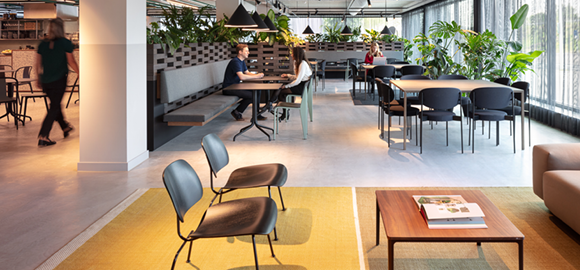The Next Normal
A complete guide to how hybrid work is impacting the workplace and transforming commercial real estate

Hybrid Work Isn’t New.
But It’s Now Normal. The pandemic accelerated the adoption of workplace flexibility, demonstrating that many people can be productive outside the office. Work now includes a multitude of digital-first tasks, such as writing emails and creating spreadsheets—which can be accomplished virtually and often were prior to COVID-19. Hybrid work is consequently something many already engaged in to varying degrees before the pandemic.
Hybrid Work Will Require a Hybrid Workplace.
With employers viewing the office as a place for collaboration and meaningful employee connection, the role of the workplace is shifting towards a more intentional work setting defined by its ability to bring people and teams together. This shift has marked implications for office design, planning and workplace equity—or balancing the in-office and virtual employee experiences.
Hybrid Work Will Lead to More Consumer-Oriented Offices.
In this ‘next normal,’ organizations will need to create differentiated offices where employees want to work. This will lead to more consumer-oriented approaches to the workplace where employers design their offices around the needs of their workforce. After a large-scale experiment in virtual work due to the coronavirus pandemic, the traditional boundaries of where work is performed are being redefined.
Individual employees overwhelmingly want the flexibility to work virtually in the future, according to research from CBRE. But most office workers also want to work in an office for at least part of the week.
Meanwhile, companies want their employees to remain productive and connected to one another. For some, this will mean a full return to the office. Others will give their employees latitude to find the right balance of work in—and outside of—the office.
The need to balance employee flexibility and organizational productivity has led companies to explore hybrid work models, which enable employees to work from the office or virtually. Their approach involves rethinking how, when and where we work.
Under a hybrid work model, employees are given greater flexibility to choose where they work, often within a set of guardrails established by leadership. This hybrid arrangement balances the benefit of time together in the office with employee expectations for greater convenience. This makes it vital for each company to define what hybrid work means for their organization and set the agenda for their employees to ensure they have time together in person.
Hybrid Work: There’s No One-Size-Fits-All Approach
Hybrid work gained prominence in the wake of COVID-19 as many companies adopted virtual work policies—almost overnight, in some cases—to ensure the health and safety of employees during the pandemic.
Today, many office workers like their newfound flexibility. In CBRE’s most recent Workforce Sentiment Survey of 10,000 employees across 18 countries, 85% of respondents said they would prefer to work virtually at least two to three days a week going forward.
For many companies, having some employees who work outside the office is not new. But the broad-scale recognition that organizations need to sustain virtual connectivity at scale and actively support a hybrid workforce marks a new approach for many such companies.
Over the past decade, technology advancements and a growing desire among employees for flexibility started paving the path to make the accelerated structural change we see today.
This evolution is already taking place. In CBRE’s 2021 Occupier Sentiment Survey, 87% of large companies with 10,000 or more employees say they will be adopting hybrid work. But these companies aren’t taking a homogenous approach to hybrid work.
By far the most popular approach to hybrid work involves setting guidance for who can—or should—be in the office and when. CBRE calls this approach “hybrid work with guardrails,” and it’s being pursued by 78% of large companies with 10,000 or more employees.
Yet each company is setting guidelines that are often unique to their organization. Some companies are requiring employees to spend a certain amount of their work week in the office. Others are taking a team-by-team approach, asking certain groups to spend more time in the office than others.
Over the coming months, many companies will need to define what hybrid work means to them. Those definitions will likely vary between organizations and will continue to be refined over time as companies collect data on what is effective—and what is not.

